Her breath is hot and acrid. As she lies next to me, chewing, I run my finger across the tuft of fur that divides flesh and claw, her soft brown paw wet with rain. She’s found a jawbone. Heavy with marrow, the gums bloody, the teeth patterned with brown spirals. In the dead grey of winter, I can only assume she’s preserved this deer jaw since the fall. She has bones buried all around the yard, waiting to be unearthed. Later, when we walk along the river between the low, wet cedar branches, she’s cagey about showing me the rest of the skull; the speckled fur still attached, the brain rotting inside. And when we lie by the woodstove in the evening, the smell of rot is trapped in her breath.
I return to this scene when I smell the earth, grass, rain, soil, and rotting logs. Author Michael Ondaatje refers to this as an archeology of memory—the smell of everywhere a dog has been, contained in a paw.1 Living with an animal that comes home scented with death and dirt has attuned me to the elemental qualities of soil. It is evocative of many things: blood, iron, rust, brick, ash, charcoal, fire, clay, ceramics, rock, sand, glass, fossils, bones, oyster shells, salt crystals, mushrooms, fungus, slime, worms, and nematodes. But what does soil evoke when removed from the natural environment, when it's placed in an art gallery?
The presence of soil in contemporary art can be thought of as continuous with the Earth Art movement of the 1960s and 1970s. Iconic works of this era include Andy Goldsworthy’s stone cairns and cracked clay walls; Michael Heizer’s geologic fissure in the Nevada desert; Walter De Maria’s Earth Room sculptures, in which the artist scattered soil across gallery floors; and Robert Smithson’s mud and basalt jetty in Utah’s Great Salt Lake. What differentiates contemporary uses of soil from these material predecessors, however, is the more recent association of soil with climate change, colonization, and resource scarcity, emphasized by environmental catastrophe.
As a material, soil carries significant conceptual weight. Whether through the soil itself, the worms aerating it, or the seeds lost amidst the loam, these ecologies demonstrate the varied and urgent ways soil nurtures life.
It’s worth considering the work of Cuban-American artist Ana Mendieta as an example of how the political landscape of art has shifted since the 1960s and 1970s, and consequently, how the associations with soil have shifted. Mendieta’s ephemeral performances were not historicized as integral works of the Earth Art movement until relatively recently. In Silueta Series (1961-1969), the artist recesses the earth in the shape of her body. The absence of her body is wholly present until a gust of wind or the tide washes the imprint away. Evocative of geopolitical histories of exile, Indigenous land claims and cosmologies, violence against women, and diasporic identity, Mendieta’s artwork aligns with contemporary political sensibilities. Her use of geologic elements elicits further association with climate change and resource extraction. I would argue that the current regard of Mendieta’s artwork, and the critical inclusion of her practice within a movement that initially disregarded her, stems from the attunement to land politics by viewers of contemporary art. We see soil as alive, connected to systems of life, we see it as land, a living and inhabited entity that risks enclosure.
As a material, soil carries significant conceptual weight. Whether through the soil itself, the worms aerating it, or the seeds lost amidst the loam, these ecologies demonstrate the varied and urgent ways soil nurtures life. Throughout this essay, I discuss the works of several contemporary artists to consider soil as a metaphor for utopia, as a site of cultural and personal memory, and as indicative of a geologic temporality incompatible with our human timescale. My analysis here acts as an exposition of soil in contemporary art to further elucidate the symbolic uses of the material.
When I first encountered soil in a contemporary art context, I was seventeen years old. I was working as a gallery assistant at a rural public art gallery while Holly Ward’s Island (2005, 2009, 2016) was installed. The North Okanagan-based artist uses sculptural and architectural elements across her practice to imagine alternative ways of living, often inspired by utopian social theory and countercultures. Island is a mound of soil piled on the gallery floor. Staff are contractually obligated to move the soil to another position once a week. For six weeks, we shovelled the soil onto a tarp and dragged it across the gallery, wearing white coveralls and documenting the process. As we shovelled, our spade broke into small green sprouts, likely growing from ghost seeds. What astonished me about this installation wasn’t the mound of dirt, nor how it undoes the conventions of a contemporary art gallery by introducing the scents of the earth into the white cube, but the incredible amount of time it took to sweep and mop the floor after moving the soil. Inevitably, the floor was painted with mud.
Holly Ward envisioned Island as an exercise in utopia. The work reveals the power dynamics in the gallery: Who else shovels the dirt and mops the floor but the seventeen-year-old gallery assistant and the curator, never paid for her overtime. Island raises questions regarding the role of each staff member and the assumptions made about their jobs. Who cleans and paints the walls, who carries plywood across town from the hardware store, and who shovels the dirt? In essence, who upholds the vision of the artist? For a utopia to function as such, these contracts must constantly be renegotiated.
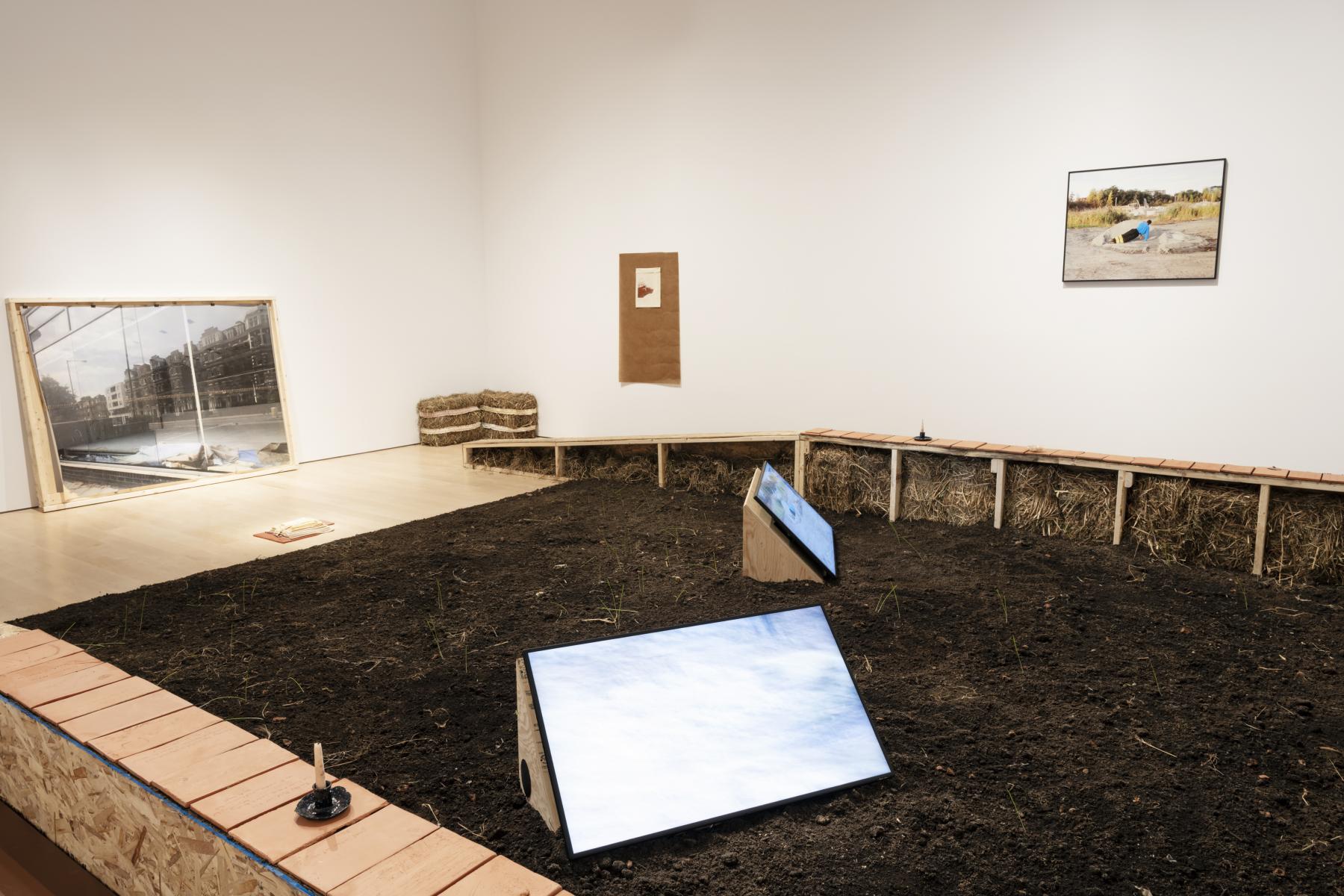
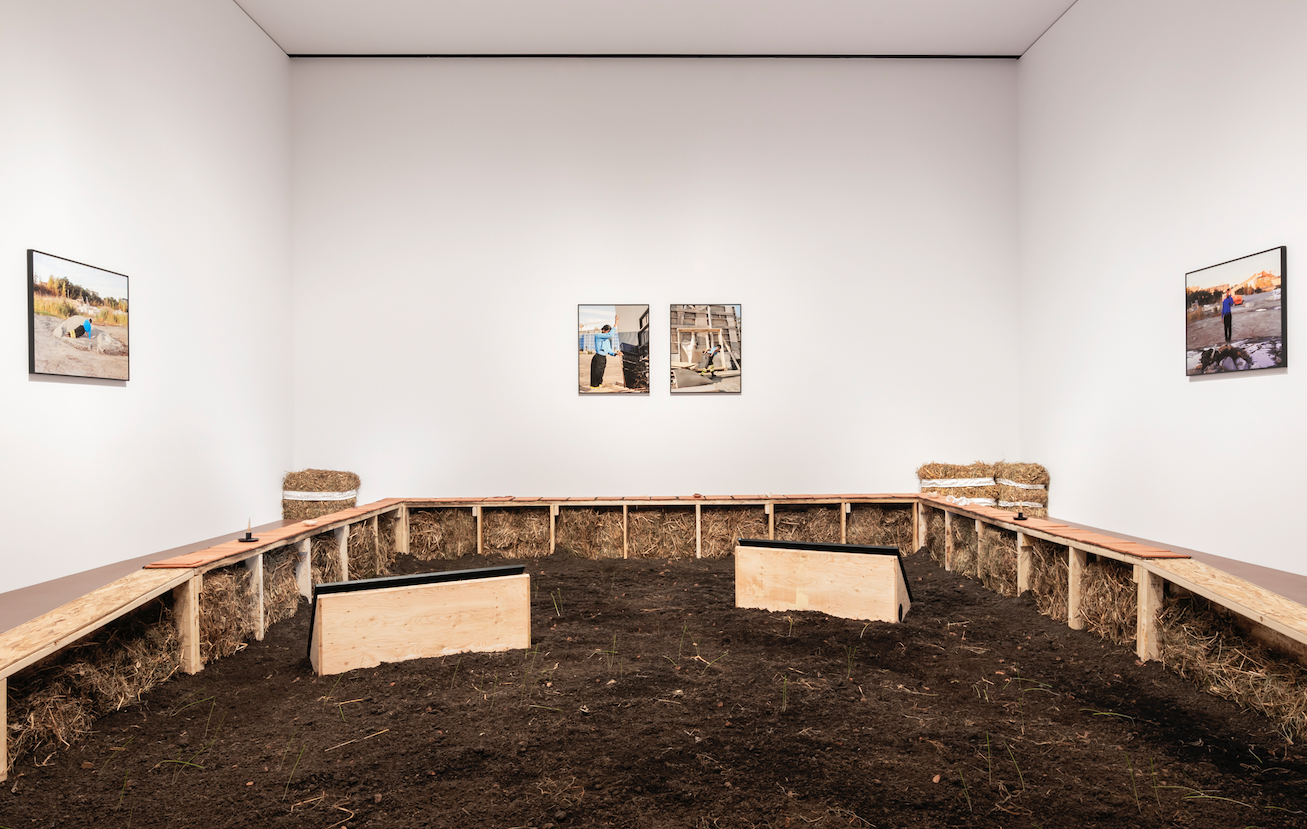
Eve Tagny, Unadorned Landscapes, 2023, installation view at Musée national des beaux-arts du Québec
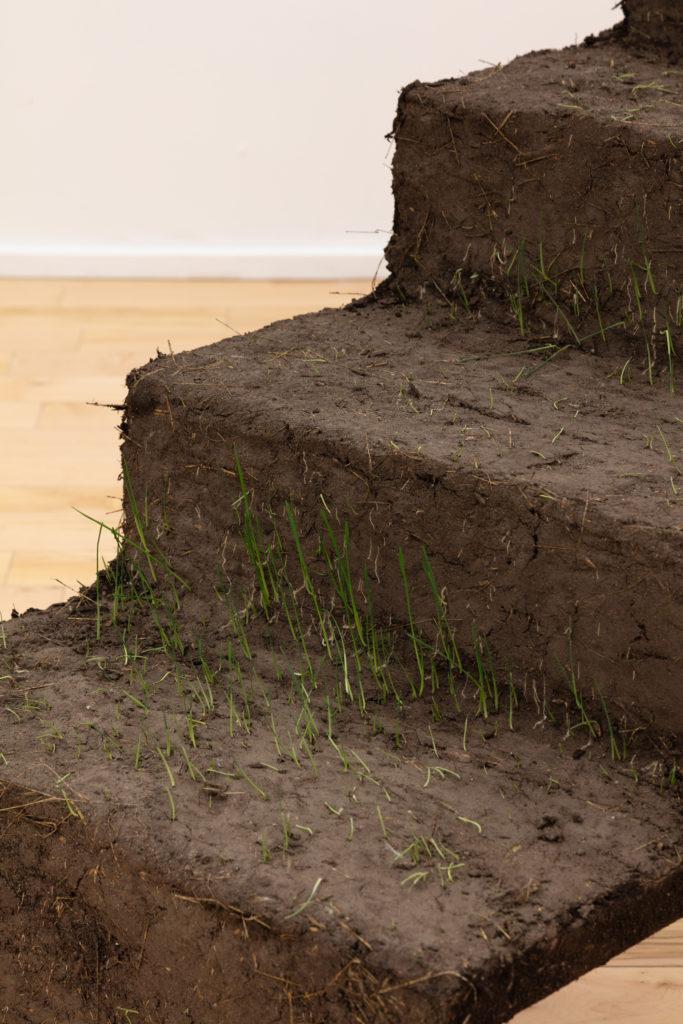
Eve Tagny, SUTURES, 2022
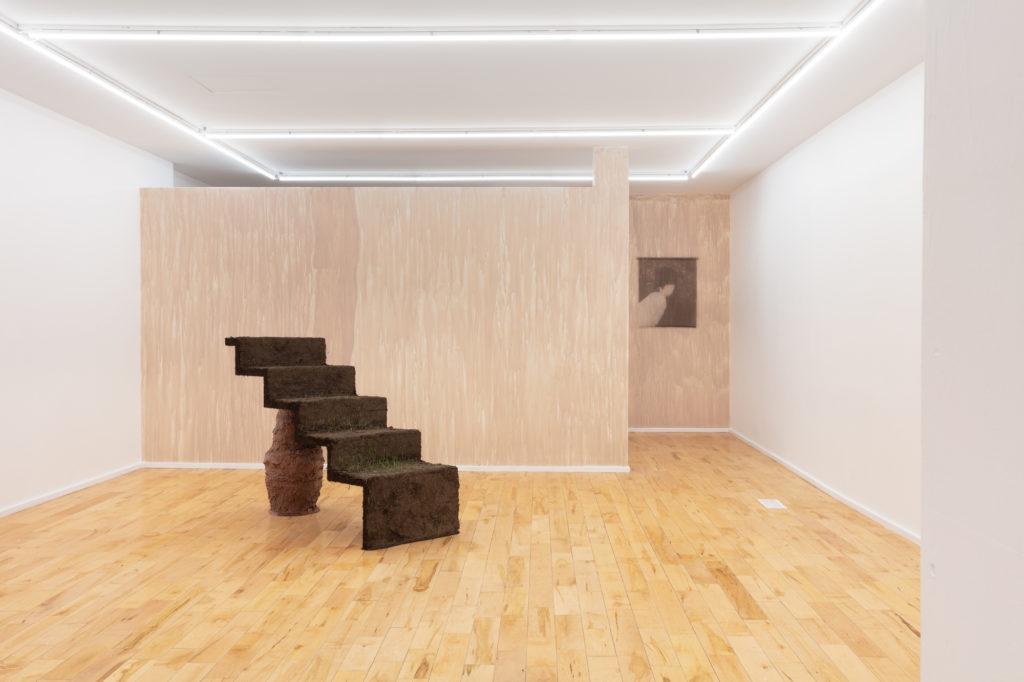
Eve Tagny, SUTURES, 2022, Visual Arts Centre of Clarington
Since my encounter with Holly Ward’s work nearly a decade ago, I’ve noticed soil recur increasingly as a material in contemporary art. Through their practice, Montreal-based artist Eve Tagny considers the relationship between land and memory. Her practice employs performance, vernacular architectures, and organic materials to consider processes of land dispossession. Their recent exhibition Unadorned Landscapes (2023), features dark loam scattered across the gallery, contained within an open frame of plywood benches. The installation was recently displayed at the Musée National des Beaux-Arts du Québec, along with photographs, video, and multimedia sculptures. Throughout the gallery, bales of hay were sporadically placed, each wrapped in a ribbon printed with quotes such as: “the origin story of private property,” and “the land feels the loss of the people who lost their rights to the land.”2 These sentences are pulled from texts about land dispossession, from feudalism and the loss of the commons in the Middle Ages to the colonization of the Americas, plantation histories, and current processes of gentrification occurring in the Montreal neighbourhood where the artist grew up. The organic materials in the exhibition evoke an autumnal garden—hay ready to be forked, soil awaiting mulch. Simultaneously, they reflect the aftermath of real estate development: the untreated plywood and terracotta-coloured tiles are reminiscent of pallets and bricks. Through these materials, Tagny combines elements of both the utopic garden and the dystopic property sector, drawing out a critique of private property and land development as strategies of capitalism and colonialism.
The loss of distinct neighbourhoods, and more broadly the loss of land, produces systemic cultural amnesia, a forced forgetting of history, language, and memory. This point is elucidated in Édouard Glissant’s collection of essays, Caribbean Discourse (1989), which describes how cultural consciousness is sedimented. The Martinique-born poet and theorist contends that land and culture are synonymous, as culture roots itself in land through a process of sedimentation. Cultural memory, composed of the collective consciousnesses of many individuals living in the same place, stratifies over time. Like silt accumulating at the bottom of a river, memory gradually accumulates into culture. As such, violent ruptures including colonialism, exile, land dispossession, and war, are obstructions to the sedimentation of consciousness, and therefore to the formation of cultural memory. The loss of place is a loss of memory; land is where culture resides.
In his 1932 essay, Excavation and Memory, Walter Benjamin similarly situates memory within land. Benjamin likens the process of remembering to an archaeological excavation, explaining that memory is not a singular entity, like a fossil or a stone, but is lodged within a strata of lived experiences. To excavate a memory, the artist must conduct a dig, noting where the memory is placed in the mind. He writes:
Genuine memory must therefore yield an image of the person who remembers, in the same way a good archaeological report not only informs us about the strata from which its findings originate, but also gives an account of the strata which first had to be broken through.3
For Benjamin, remembering is a process of accumulation, of digging through the dark to note the quality of the soil. A shovel cuts through layers of black earth, a pocket of rocks, wet clay and dust, in the same way that traumas, joy, and the banalities of life sit atop one another in the mind. For the process of remembering to conjure meaning for the viewer, the artist must express the interdependence of their memories, the strata of the self.
An iridescent mirror flush with the earth is an image artist Sara K. Maston returns to again and again. The image recalls a childhood memory in which the artist imagined her mother’s gravestone as a mirror, or a portal, in the ground. Maston iterated this scene in the outdoor exhibition, Garden Variety Vol 1 (2021) organized by Toronto-based curator Erin Storus, in which the work of three artists was arranged in a backyard garden. Influenced by elements including a garden fence, a lawn of green grass, and a border of perennials, the works in the exhibition included a glimmering work called Hole by Sara K Maston. The piece features a painting of a pink moth floating in a hole dug by the artist. Although I think the work was made by filling the hole with water and floating a painted, translucent film atop the surface, I’m also open to the possibility that Maston’s alchemical process opened a portal in the ground to a place where nocturnal pollinators conspire with worms and mycelium. This work epitomizes Benjamin’s thesis of personal archeology, as the hole is filled with the artist’s memory, stratified in the earth.
Soil is often thought of as insignificant. I only began to consider soil several years ago when an abandoned compost bin in my backyard yielded some especially beautiful soil. At the time I was living with a soil scientist who helped me to understand what it meant that soil is a nonrenewable resource. While I had heard that statement, the environmental impact only recently occurred to me—we will run out of soil. The accumulation of matter and its fermentation into soil occurs on a non-human timescale, making it nonrenewable4. In our lifetimes, we will never restore the quantities of soil we have already made toxic, acidic, or depleted of essential nutrients. This is particularly concerning when soil is considered a waste product of large-scale agriculture, and is treated with chemicals to a point of irrevocable toxicity.
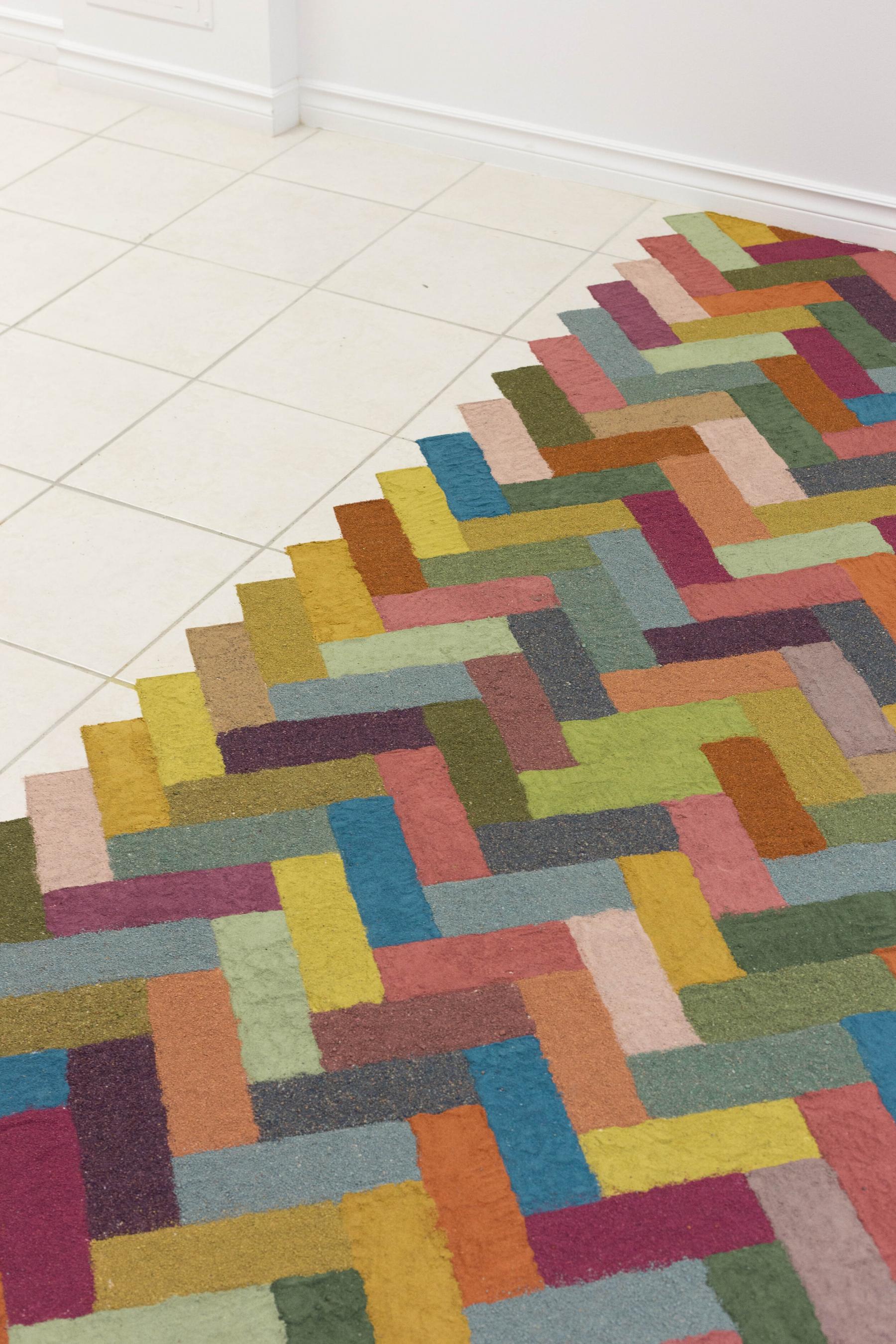
Shannon Garden-Smith, Sand Silhouette, 2021, Dyed sand, approximately 111” x 60”

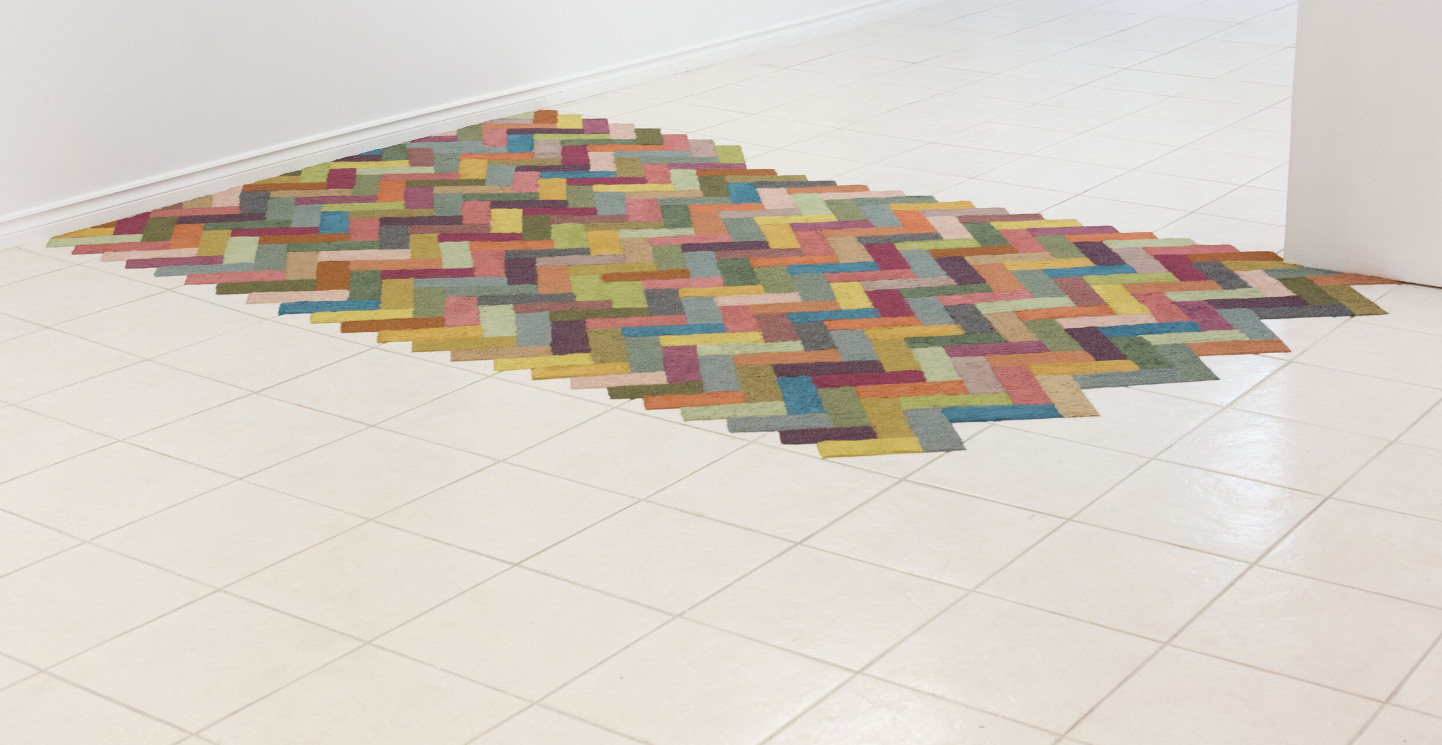
Shannon Garden-Smith, Sand Silhouette, 2021, Dyed sand, approximately 111” x 60”
Toronto-based artist Shannon Garden-Smith considers these timescales through her use of sand. Concerned with the geopolitics of the material and its non-renewability, the artist creates installations that reflect the human-geological relationship with sand, and its use in the property development sector. In Sand Silhouette (2021) installed at the plumb, an artist-run-centre located in Toronto, Garden-Smith created a herringbone pattern out of coloured sand that viewers were invited to walk on throughout the course of the exhibition. As the weeks wore on, the herringbone pattern softened, colours blended and footprints left indexes of the viewers’ paths. The title Sand Silhouette, refers to a form of archaeological remains called a trace fossil, that captures the movement of bodies rather than the body itself. These fossils are often footprints or silhouettes that have compacted over time. Through the social element of her sand sculptures, Garden-Smith mimics how our bodies are indexed in the architectures we live in, our footprints trapped in cement after a fresh sidewalk pour, our fingertips swirling around in compressed dust. Her ephemeral sculptures reveal a geologic time scale through a poetics of indexes, pointing to the non-renewability of sand and soil alike.
In her 2021 book On Freedom, author Maggie Nelson recalls struggling to comfort her eight-year-old son when he asks if an environmental disaster will kill him. Concerned with the stories we tell ourselves about climate change, Nelson suggests that our dualistic, simplified narratives are spurred by the incomprehensibility of a geologic temporality. As Nelson contends, “One might say that the tragedy of global warming is in part a tragedy of greed, and in part a tragedy of the human mind’s—or some human minds’—failure to apprehend or care about deep time.”5 The rapid unfolding of climate change brings to light the chasm between human and geologic timescales. We are unable to comprehend just how slow the underground accumulation of carbon is, compared to the speed at which carbon is pilfered and burned. The breakdown of rotting logs, egg shells, flower petals, and dust, into soil, is incomprehensible to us. As humans, there are profound limits to our understanding of time, especially within the capitalist and colonial logic of extraction, which sees ahead only to the next payout.
At the edge of the river, a dog digs through the sand. Her pregnant belly slows her, as she works her way into a wet layer of earth that stinks like fish. After a few mouthfuls of dirt, we return to the house. She arches her back by the wood stove. A mound of clotted blood falls from her legs. She licks up enough of the mess that I see a small, wriggling dog enveloped in a translucent sac, stretching out its arms as it’s licked, tearing its way into life. I’m reminded that my neighbour planted a tree in each of her children’s placentas: A beech for Beatrice and an oak for Arrow. I think about the river that I grew up on. In August the hot air is ripe with fish, the shore littered with salmon skin and spines. A merciless eagle needs only to graze its talons on the water to spear a fish. The black bears drag bones and guts to the forest to rot. This is the organic matter that soil is made of, the pith of life.